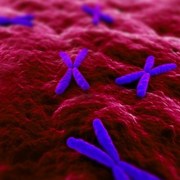 Hemera/Thinkstock
Hemera/Thinkstock
A genetic disorder, Klinefelter syndrome affects one in every 500 to 1,000 males, according to Genetics Home Reference. With Klinefelter syndrome, also called XXY condition, the individual has an extra X chromosome in most of his cells.
Normally, males have one X chromosome and one Y chromosome. So instead of having 46 chromosomes, individuals with Klinefelter syndrome have 47 chromosomes.
However, in some cases of the Klinefelter syndrome, the individual has 46 chromosomes in some cells, and 47 chromosomes in other cells. This is called mosaic Klinefelter syndrome and may result in milder symptoms.
This genetic disorder does not occur in women.
Klinefelter syndrome is not an inherited genetic disorder. Instead, it is caused by a random event.
Genetics Home Reference explained that the cause of Klinefelter syndrome is an error in cell division, which is called nondisjunction, that occurs during the formation of the reproductive cells. The nondisjunction results in an abnormal number of chromosomes, so an egg or sperm may have an additional X chromosome.
In cases of mosaic Klinefelter syndrome, the cause is also a random event during cell division, which Genetics Home Reference noted occurs early in the development of the fetus.
Because the cause of Klinefelter syndrome is a random event, there are not specific risk factors. Women who become pregnant when they are older than 35 have a higher risk of giving birth to a child with Klinefelter syndrome, but the MayoClinic.com noted that it is only a slightly increased risk.
Having the extra X chromosome can affect development of the individual. Three areas of the development are affected by Klinefelter syndrome, which are language, physical and social. The National Institute of Child Health and Human Development noted that between 25 and 85 percent of males with Klinefelter syndrome have language difficulties, such as problems with reading and verbal expression.
Physical development difficulties that may occur include less muscle coordination, less facial hair and larger breasts. During the teenage years, young men with Klinefelter syndrome tend to be shy.
To diagnose Klinefelter syndrome, lab work is done that examines the individual’s chromosomes and hormones. For example, a karyotype analysis will check the number and shapes of the individual’s chromosomes, and is used to confirm the diagnosis of the syndrome. A hormone test may also be done, which uses urine or blood samples to check for abnormal hormone levels.
References
Genetics Home Reference. Klinefelter Syndrome. Web. 16 April 2012
http://ghr.nlm.nih.gov/condition/klinefelter-syndrome
National Institute of Child Health and Human Development. Klinefelter Syndrome. Web. 16 April 2012
http://www.nichd.nih.gov/health/topics/klinefelter_syndrome.cfm
MayoClinic.com. Klinefelter Syndrome. Web. 16 April 2012
http://www.mayoclinic.com/health/klinefelter-syndrome/DS01057/METHOD=print
MedlinePlus Medical Encyclopedia. Klinefelter Syndrome. Web. 16 April 2012
http://www.nlm.nih.gov/medlineplus/ency/article/000382.htm
Reviewed April 16, 2012
by Michele Blacksberg RN
Edited by Jody Smith






Add a Comment1 Comments
Please visit the national organization that is dedicated to providing education and support for this syndrome at this website:
www.genetic.org
Gary
April 16, 2012 - 1:19pmThis Comment